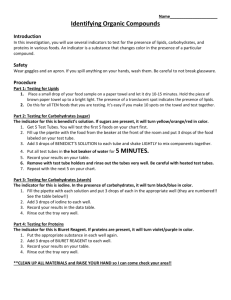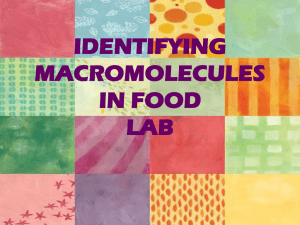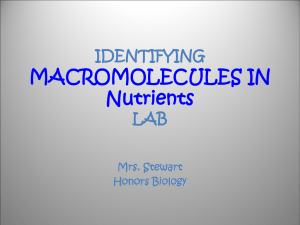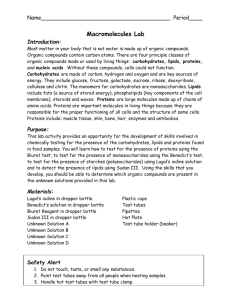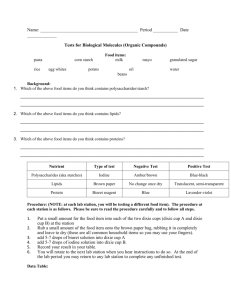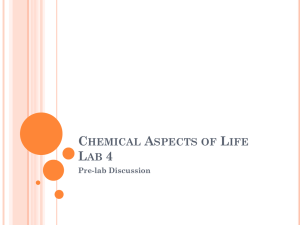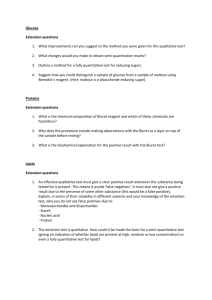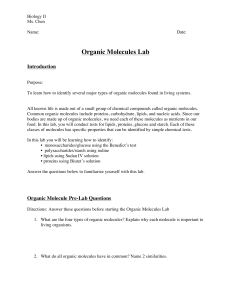Biologically Important Molecules Lab Worksheet
advertisement
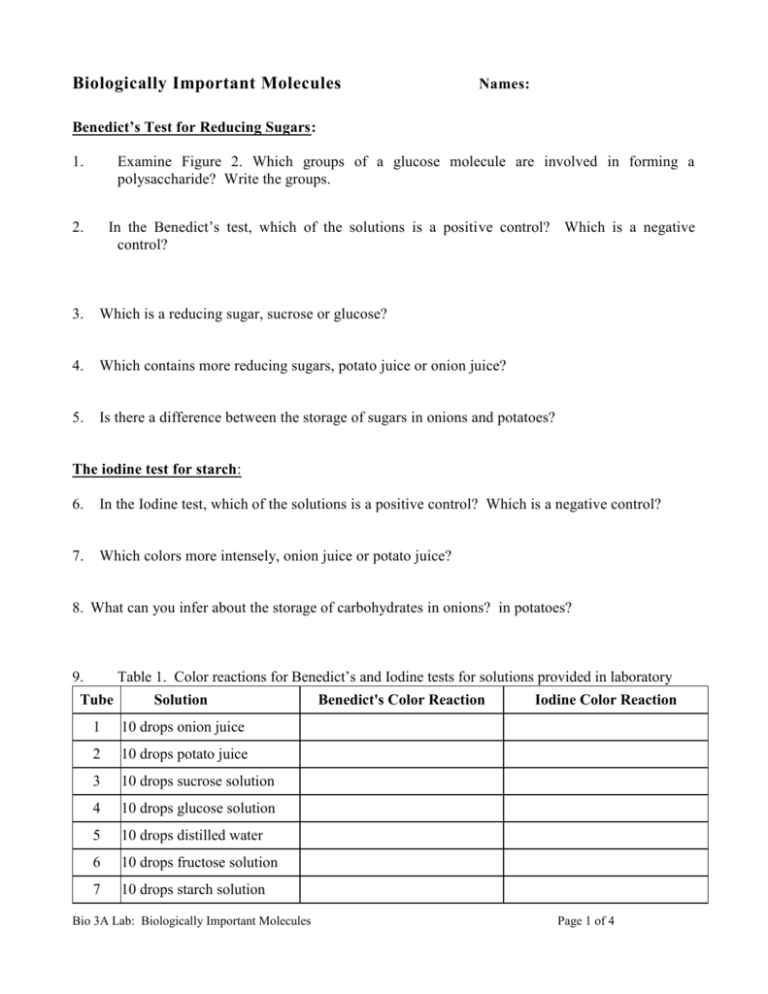
Biologically Important Molecules Names: Benedict’s Test for Reducing Sugars: 1. Examine Figure 2. Which groups of a glucose molecule are involved in forming a polysaccharide? Write the groups. 2. In the Benedict’s test, which of the solutions is a positive control? Which is a negative control? 3. Which is a reducing sugar, sucrose or glucose? 4. Which contains more reducing sugars, potato juice or onion juice? 5. Is there a difference between the storage of sugars in onions and potatoes? The iodine test for starch: 6. In the Iodine test, which of the solutions is a positive control? Which is a negative control? 7. Which colors more intensely, onion juice or potato juice? 8. What can you infer about the storage of carbohydrates in onions? in potatoes? Table 1. Color reactions for Benedict’s and Iodine tests for solutions provided in laboratory 9. Tube Solution 1 10 drops onion juice 2 10 drops potato juice 3 10 drops sucrose solution 4 10 drops glucose solution 5 10 drops distilled water 6 10 drops fructose solution 7 10 drops starch solution Bio 3A Lab: Biologically Important Molecules Benedict's Color Reaction Iodine Color Reaction Page 1 of 4 Testing for Proteins: 10. Table 2. Color Reactions for the Biuret Test for solutions provided in the laboratory Tube Solution Color 1 2 ml egg albumen solution 2 3 4 5 2 ml honey solution 2 ml amino acid solution 2 ml distilled water 2 ml protein solution 11. 12. Circle and label the reactive amino and carboxyl groups on the four common amino acids shown below: In the Biuret’s test, which of the solutions is a positive control? Which is a negative control? 13. Which contains more protein (C-N bonds), egg albumen or honey? 14. Do free amino acids have peptide bonds? Explain why or why not. Testing for Lipids: 15. Examine Figure 7. What are the reactive groups of the fatty acids? Solubility of Lipids in Polar and Non-polar Solvents 16. What do you conclude about the solubility of lipids in polar solvents such as water? 17. What do you conclude about the solubility of lipids in non-polar solvents such as chloroform? Bio 3A Lab: Biologically Important Molecules Page 2 of 4 The Sudan IV Test for Lipid 18. Table 3. Reactions for the Sudan IV Test for solutions provided in the laboratory Tube Solution 1 l ml salad oil + water 2 1 ml salad oil + water + Sudan IV 3 1 ml honey solution + Sudan IV 4 1 ml distilled water + Sudan IV Description of Reaction 19. Is salad oil soluble in water? 20. Compare tubes 1 and 2 in the Sudan IV test. What is the distribution of the dye with respect to the separated water and oil? 21. What observation indicates a positive test for lipid? 22. Does honey contain much lipid? 23. Lipids supply more than twice as many calories per gram as do carbohydrates. Based on your results, which contains more calories, oil or honey? The Grease-spot Test for Lipids 24. Table 4. Grease Spot Reactions for materials provided in laboratory Item Food Product Description of Grease-spot Reaction 1 2 3 4 5 25. Which of the food products that you tested contains large amounts of lipid? Bio 3A Lab: Biologically Important Molecules Page 3 of 4 Testing for Nucleic Acids: 26. How does the color compare between tubes 1 and 2? Why? 27. Do DNA and RNA react in similar ways? Why or why not? 28. Table 5. Dische Diphenylamine Reactions for materials provided in laboratory Tube Solution 1 2 ml DNA solution 2 1 ml DNA solution, 1 ml water 3 2 ml RNA solution 4 2 ml distilled water 29. Color Reaction Saddleback CSI – Identification of Unknown Table 6. Results of Five Biochemical Test on an Unknown Biochemical Test Color Sample Unknown Result Controls (+/-) Benedict's test Iodine (starch) Biuret test (protein) Dische diphenylamine test (DNA) Sudan IV (lipid) Identity of the CSI Unknown Bio 3A Lab: Biologically Important Molecules Page 4 of 4
